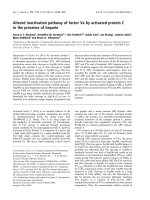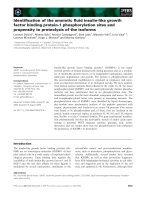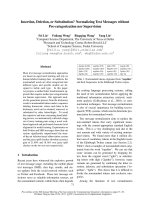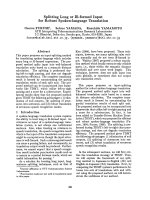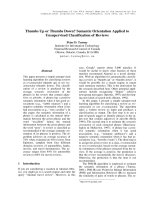Báo cáo khoa học: "To be or not to be protease activated receptor-1 in activated protein C-initiated endothelial barrier protection" potx
Bạn đang xem bản rút gọn của tài liệu. Xem và tải ngay bản đầy đủ của tài liệu tại đây (30.31 KB, 2 trang )
Page 1 of 2
(page number not for citation purposes)
Available online />The review by Looney and Matthay summarized recent
progress in basic and preclinical research of activated protein
C (APC), a novel therapeutic agent for the treatment of
severe sepsis [1]. APC is traditionally an anticoagulant and
profibrinolytic agent, and has been appreciated to possess
anti-inflammatory and anti-apoptotic properties, yet the exact
mechanisms by which APC executes its clinical effects in
sepsis are not defined [2]. Emerging evidence has suggested
that APC might exert its clinical benefit, at least in part, by
maintaining endothelial barrier function [3,4]. The authors
reviewed conflicting results of endothelial barrier protection
of APC in the literature and pointed out that caution must be
taken to interpret cell culture experiments and their
relationship to in vivo conditions. Indeed, one should exercise
caution while reviewing controversial data.
Looney and Matthay stated that ‘in two different in vitro
investigations [3,4], APC promoted endothelial barrier
protection in a PAR-1- and S1P
1
-dependent mechanism’,
which represents a misinterpretation. These two papers did
conclude that APC enhanced endothelial barrier function in
different cell lines by a sphingosine 1-phosphate receptor-1
(S1P
1
)-dependent signaling pathway, but it is still arguable
whether this is protease activated receptor-1 (PAR-1)
dependent. Finigan and colleagues showed that anti-PAR-1
blocking antibody did not interfere with either APC-mediated
myosin light-chain phosphorylation or S1P
1
receptor
phosphorylation/activation, and concluded that it was
endothelial protein C receptor (EPCR) ligation with APC and
the resulting S1P
1
transactivation that led to endothelial cell
cytoskeletal rearrangement and barrier protection [4]. There
is therefore no evidence so far to support the notion that the
‘APC … effect on endothelial cytoskeletal rearrangement …
appears to operate in a PAR-1- … dependent manner’ [1].
Letter
To be or not to be protease activated receptor-1 in activated
protein C-initiated endothelial barrier protection?
Shi-Sheng Li
Department of Molecular & Experimental Medicine, The Scripps Research Institute, 10550 North Torrey Pines Road, La Jolla, CA 92037, USA
Corresponding author: Shi-Sheng Li,
Published: 19 February 2007 Critical Care 2007, 11:407 (doi:10.1186/cc5149)
This article is online at />© 2007 BioMed Central Ltd
See related review by Looney and Matthay, />APC = activated protein C; EPCR = endothelial protein C receptor; PAR-1 = protease activated receptor-1; S1P
1
= sphingosine 1-phosphate
receptor-1.
Authors’ response
Mark R Looney and Michael A Matthay
We agree with Dr Li that reconciling the in vitro and in vivo
effects of APC is a complicated endeavor. It is still not clear how
APC and thrombin, operating through the same receptor (PAR-
1), can induce sometimes opposite effects. The role of EPCR
and PAR-1 is clear regarding APC’s anti-apoptotic effects –
both receptors are essential [5]. The role of EPCR in APC’s
endothelial barrier protection is also clear – it is also essential,
as reported in two different investigations [3,4]. We disagree on
the role of PAR-1 in endothelial barrier protection. Feistritzer and
Riewald showed convincingly that APC’s barrier-enhancing
properties were abolished by PAR-1 blocking antibodies [3].
The only more conclusive experimental results would be
obtained by challenging endothelium from PAR-1 knockout
animals with thrombin and APC. The investigation by Finigan
and colleagues admittedly focused more on the role of EPCR,
and only tested the role of PAR-1 mechanistically and not in the
transendothelial electrical resistance experiments [4]. Much
more clearly remains to be discovered about APC and its many
potential beneficial properties, including its activation of PAR-1
and endothelial barrier protection.
Page 2 of 2
(page number not for citation purposes)
Critical Care Vol 11 No 1 Li
Competing interests
The authors declare that they have no competing interests.
References
1. Looney MR, Matthay MA: Bench-to-bedside review: The role of
activated protein C in maintaining endothelial tight junction
function and its relationship to organ injury. Crit Care 2006,
10:239.
2. Mosnier LO, Zlokovic BV, Griffin JH: The cytoprotective protein
C pathway. Blood 2006 [Epub ahead of print].
3. Feistritzer C, Riewald M: Endothelial barrier protection by acti-
vated protein C through PAR1-dependent sphingosine 1-
phosphate receptor-1 crossactivation. Blood 2005, 105:
3178-3184.
4. Finigan JH, Dudek SM, Singleton PA, Chiang ET, Jacobson JR,
Camp SM, Ye SQ, Garcia JG: Activated protein C mediates
novel lung endothelial barrier enhancement: role of sphingo-
sine 1-phosphate receptor transactivation. J Biol Chem 2005,
280:17286-17293.
5. Cheng T, Liu D, Griffin JH, Fernandez JA, Castellino F, Rosen ED,
Fukudome K, Zlokovic BV: Activated protein C blocks p53-
mediated apoptosis in ischemic human brain endothelium
and is neuroprotective. Nat Med 2003, 9:338-342.


